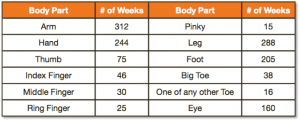What is a Scheduled Loss of Use Award?
A scheduled loss of use award is a type of workers’ compensation award that is given to people who have permanent, work-related injuries to their extremities (arms, hands, feet, legs). This is different from the kinds of awards given to people with “classified injuries,” which are permanent work-related injuries to non-extremities (back, head, neck, organs, etc.). In this post, we will discuss how Scheduled Loss of Use Awards are calculated.
In order to determine how much your Scheduled Loss of Use Award will be, you first need a doctor to determine your Scheduled Loss of Use (or SLU). SLU is a percentage number that a doctor assigns to your injury to reflect how much function you lost as a result of your injury. SLU is initially determined by a doctor after you reach maximum medical improvement (MMI), which is the point at which a doctor decides your injury is not going to get any better. At this point, the doctor evaluates your injury and decides how much function, in terms of percentages, you lost in your injured body part. For instance, if your thumb was cut off, then you have a 100% loss of use of your thumb because you can no longer use your thumb at all. But, if you broke your arm and now you can’t lift it over your head, your doctor will assign some percentage less than 100% since your use of that arm is limited, but not completely gone. Once the doctor assigns a percentage, you can then look at the Scheduled Loss of Use Chart to determine how many weeks you can collect workers’ compensation benefits.
The SLU Chart uses the 1996 Medical Guidelines to set the number of weeks allowable for particular injuries. As a guide, the maximum number of weeks allowable for 100% loss of use of certain body parts is as follows:
To determine how many weeks you can collect benefits, take the number above associated with your injured body part and multiply it by your percentage loss of use. For instance, if you have a 50% loss of use of you index finger, you are entitled to 23 weeks of benefits (46 weeks x .5). Then, take that number and multiply it by your maximum allowable benefit, which is 2/3 of your average weekly wage. So, you can calculate your SLU Award by using this formula:
(Average Weekly Wage ÷ 2/3) x (Max. No. of Weeks Allowed x % Loss of Use)
Consider this example: Peter injured his arm on the job and, after reaching maximum medical improvement, was found to have a 25% loss of use of that arm. Peter’s average weekly wage was $600, so his maximum benefit is 2/3 of that amount, totaling $400 per week. The Scheduled Loss of Use Table says a 100% loss of use of an arm is worth 312 weeks. Peter then multiplies 312 by .25 and determines he is entitled to 78 weeks of benefits. $400 multiplied by 78 weeks equals $31,200. That is Peter’s total Scheduled Loss of Use Award.
Now Peter has two options: he can either take that benefit at $400 per week for 78 weeks OR he can petition the Workers’ Compensation Board for a lump sum payment of the total $31,200. Which decision is best for Peter depends on his personal circumstances. Also, if Peter has already collected some benefits, that amount will be deducted from his total award. For more information on Scheduled Loss of Use Awards, please contact one of our attorneys.
Also, be sure to check back for our next post on “Classified Injuries,” where we will discuss on the job injuries that are not categorized by the Schedule Loss of Use Chart, such as back injuries, head injuries and neck injuries.



